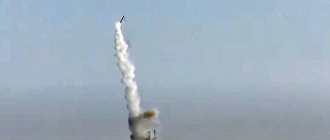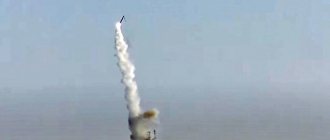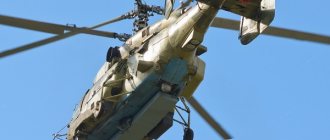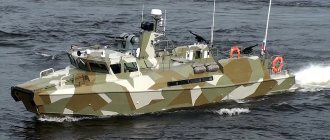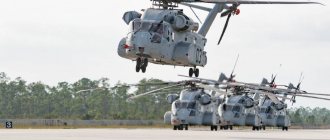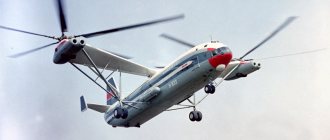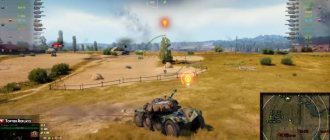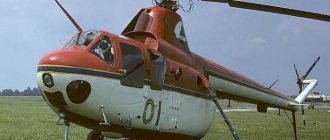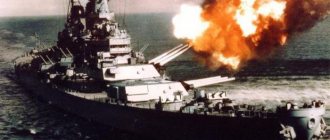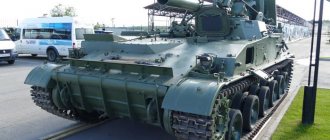The Ministry of Industry and Trade has once again allocated a tidy sum for the development of technologies that will help speed up our helicopters. This time we are talking about an amount of almost 1 billion rubles. For this money, the department wants to develop new helicopters and rotary-wing aircraft (code “Dragonfly”), the speed of which will reach a fantastic 700 km/h.
The answer to the question of who will be the winner of the tender will be known in mid-August. Life's source in the aviation industry believes that, most likely, since this is a research development (R&D), it will be dealt with by a design bureau or some institute, for example TsAGI (Zhukovsky Central Aerohydrodynamic Institute).
In total, 7.5 billion rubles were allocated from the budget for the creation of a promising high-speed helicopter (PSH). Representative of the Ministry of Industry and Trade Yuri Slyusar spoke about this in 2014. At the same time, in 2013, Russian Helicopters won a competition for research work to create a promising helicopter, within which 2.5 billion rubles were allocated. Most of this amount was received by the plant named after. Mil, the funds were used to develop a preliminary design (this is a preliminary stage of the development of PSV).
In 2014-2015, it was planned to allocate about 4 billion rubles for these purposes within the framework of the state contract.
McDonnell Douglas AH-64 Apache | Speed 293 km/h
The McDonnell Douglas AH -64 Apache is the most common attack aircraft in the world and is also one of the fastest. Its manufacturer is , which has not a single airborne aircraft capable of boasting excellent speed characteristics. The aircraft appeared in the mid-70s of the last century. It was then that the first test flight of this model took place. The maximum speed that the Douglas AH-64 Apache can reach is 293 km/h. Helicopter production continues to this day. In total, there are more than 2 thousand air units, which are in service with many countries, including the USA, Japan, the Netherlands and other countries.
Mi-28N
Developed by the Mil Design Bureau and entered into service in 2013, the Mi-28N, in Russia called the “Night Hunter”, and according to NATO classification under the formidable call sign “Devastator”, has already proven itself as a reliable combat attack helicopter during the anti-terrorist operation in Syria.
Mi-28N, Photo: mil.ru
The development of the Mi-28, which was headed by the then general designer of the Moscow Helicopter Plant. The Mark Weinberg mile began back in the 78th year of the last century as part of a competition with the Kamov design bureau, and 4 years later the first prototype took off. Since then, the helicopter design has undergone many modifications and only at the beginning of the new millennium it took on its final form.
The crew of the helicopter, capable of taking off with a combat load of 2.5 tons, consists of two pilots. The cruising speed of the model, which, in addition to the Russian army, is also in service in Iraq and Algeria, is 265 km/h, but the car can accelerate to 300 km/h in flight. “Night Hunter” is not a helicopter that flies only in a straight line : The rotorcraft is capable of performing aerobatic maneuvers, including a barrel roll, Nesterov loop and Immelmann flip.
KA-52 | Speed 300 km/h
The KA-52 ranks ninth in the list of the fastest aircraft in the world. The aircraft, also known as the Alligator, was developed in the early 20th century by helicopter. It is a modified model of the KA-50. The Alligator test took place in 1997. Then the helicopter showed maximum results of 300 km/h. The production of aircraft of this type continues to this day. At the moment there are about a hundred copies. All units are in service with the Russian Aerospace Forces. In the near future, it is planned to produce machines that will be exported.
Mi-24
One of the most famous helicopters in the world and the second most common, which is named “Lan” in the NATO classification, is the Mi-24, which, since its first flight in September 1969, has taken part in a whole string of armed conflicts across the planet. The rotorcraft, developed by the Mil Design Bureau half a century ago, is still actively used by the armed forces of many countries - modifications of the attack helicopter are used by more than 60 countries.
Mi-24, photo: commons.wikimedia.org
The Mi-24 project, the creation of which was initiated by a resolution of the Council of Ministers of the Soviet Union dated May 6, 1968, took into account developments previously used in the design of previous models created by the design bureau. At the time of its production, the Soviet helicopter, more familiar to residents of Russia and the CIS under the aggressive nickname “Crocodile”, became the second in the world intended exclusively for combat use - the first was the American Cobra - AH-1.
A distinctive feature of the Mi-24 is its tandem control cabin, in which the pilot and crew commander are located one above the other. Another characteristic feature is the negative angular deviation of the wing from the base plane of 12 degrees, due to which up to a third of the lifting moment is created. The helicopter is capable of accelerating in horizontal flight up to 335 km/h.
NHI NH90 | Speed 300 km/h
NHI NH 90 is one of the fastest multi-role helicopters developed by Eurocopter in 1995. During tests of the air vehicle, indicators of 300 km/h were obtained. Today, the NHI NH90 is operated and in service by more than a dozen countries, including France, Germany, Italy, Sweden, etc. The cost of one unit today is about 45 million US dollars. Currently, aircraft are produced by Agusta/Westland and Stork Fokker.
Why is all this needed?
The Ministry of Industry and Trade noted that the global helicopter industry has adopted long-term programs to significantly improve the flight safety characteristics and flight technical and environmental characteristics of promising helicopters. As part of these programs, experimental helicopters were developed that exceeded flight speeds of 460 km/h. Therefore, it is necessary to achieve these indicators and even exceed them.
Increasing speed is a good thing, because the faster the helicopter, the more cargo it can transport in the same time. But it is also very important that the price of this increase is not too high.
According to Oleg Panteleev, in the early 1990s, the USSR created a prototype of the Yak-141 supersonic vertically taking off carrier-based fighter. But in the payload-range diagram the characteristics of this aircraft were so modest, and in the cost column they were so provocative that the program was not developed.
If we are talking about commercial companies that need to make a profit, then designers and developers have to solve the optimization problem, also introducing operating cost parameters into the equation. It is important to make a high-speed helicopter not at any price, but for one that the buyer is willing to pay, both for owning a fast car and for every hour of flying on it.
— Scientific developments in this area are very important to expand understanding of the problem, to determine what knowledge and technologies we lack in order to make a new breakthrough and create a new generation of helicopters. The result of the work will not necessarily be something revolutionary; it may also turn out that a couple of “tricks” will be found that will allow for very reasonable money to increase the cruising speed by 10 percent. This will also be an important result,” Panteleev sums up. - Moreover, if the possible result turns out to be unsatisfactory, this will not mean that the work has failed. The main thing is to understand where the boundaries of what is possible at the current level of technological development are, and how far these boundaries can be pushed if new technologies are created and applied.
The expert noted three possible areas of application of the development. And the first of them is use by military customers.
— Modern military operations require that a strike be delivered quickly, suddenly, from unprepared sites. The second is special operations. For example, search and rescue - if you delay a little and there will be no one to save, everyone is already frozen or drowned. Third, servicing remote offshore platforms. If the drilling site is several hundred kilometers away, then you need to have a longer flight range. And high speed would not be superfluous, so that it would be possible to get there and back faster - in one work shift of one crew,” says Panteleev.
Life asked the experts who are developing simulators of combat helicopters for the Russian army: how much the speed of a rotorcraft can affect the reduction in the number of cases of a helicopter being hit by air defense weapons. The expert was relentless; the speed of the helicopter would not help him evade air defense systems.
— All aviation strike weapons have a flight speed of 700-800 km minus 200. Their weapons are located on external beam holders. And the strength of these holders limits the speed. For missiles that fly at a speed of approximately 2 thousand km/h, these targets are low-maneuverable and do not pose any difficulties. Shooting down a flying helicopter will not be a problem. In air defense there are not only MANPADS, there are also mobile systems, air defense systems, etc. MANPADS are located directly in combat formations. It’s very difficult to bypass air defense, you have to somehow overcome it,” Vladimir Rastopchin, a designer from , which is developing a simulator of combat helicopters for exercises, told Life.
As experts say, in order for a helicopter to be more invulnerable to air defense systems, the emphasis must be placed not so much on speed, but on the development of advanced means of protection.
7. AgustaWestland AW139 | Speed 310 km/h
The AgustaWestland AW139 is the fastest aircraft developed by the Anglo-Italian company Agusta together with Bell Helicopters. The first test flight of the aircraft took place in 2001. Then the aircraft showed its maximum speed, which reached 310 km/h. The vessel's cruising speed can reach 306 km/h. The cost of one unit of AW139 today is about 30 million US dollars. The model also boasts that it is one of the safest helicopters in the world. AgustaWestland AW139 is operated by many foreign countries, including Russia.
The best Russian helicopters
Our country has long occupied a leading position in the development and production of helicopters. Even the United States, which has the most modern military technology, purchases some Russian-made helicopters. The reasons for this are the simpler, but not inferior to American analogues, helicopter design and intuitive controls.
Black Shark is one of the best helicopters in the world
Over the past few years, the Russian military-industrial complex has ranked first in the world in terms of growth rates. More and more helicopter models are already being supplied to the troops, and by 2022 their number should be more than 1,100 vehicles. Including new modifications of the legendary “Black Shark”, Ka-50.
Ka-50 is one of the best Russian helicopters
This helicopter is undeservedly bypassed by various ratings, and only because its mass production never began. Only 15 units of the Ka-50 were produced, and therefore it remained in the category of experimental helicopters. It has excellent flight characteristics, excellent maneuverability and a speed of over 400 km/h. An improved model, the Ka-52, will now be produced.
Ka-52 - an improved version of the Ka-50 “Black Shark”
The second main helicopter proposed for delivery to the Russian Air Force is the Mi-28N. It is made according to the “classical” scheme, which has its disadvantages, but also good advantages. It also showed good results in flight tests, only slightly inferior to the Ka-52.
MI-24 | Speed 320 km/h
MI-24 is the fastest Soviet helicopter, created on the basis of the MI-14. The first copy, like the subsequent ones, were assembled at the Moscow Helicopter Plant. The first flight took place in the fall of 1969. During experimental tests, the MI-24 showed excellent results, which amounted to 320 km/h. Subsequently, the model underwent many modifications and improvements in order to improve flight characteristics and operational features. Modified models are capable of accommodating up to 8 crew members and 4 wounded on stretchers. Currently, MI-24 is operated in Russia, foreign countries and CIS countries.
The fastest production helicopters
What other helicopters are included in the list of the best helicopters in the world for their speed performance? The Mi-24 helicopter, codenamed "Lan", which is essentially a hybrid of a helicopter and an airplane, was released in 1969. This heavy and clumsy-looking helicopter fought in mountain gorges, in the deserts and forests of Africa, and in Afghanistan it became a symbol of that war.
The fast Mi-24 helicopter became legendary in the war in Afghanistan
Despite its bulky appearance, the Mi-24 can develop quite decent speed. This helicopter is one of the fastest combat helicopters in the world. Its speed can reach 320 km/h. This machine has become a truly terrifying weapon for the enemy. Afghan militants said about him: “We are not afraid of the Russians, but we are afraid of their helicopters!”
The famous “Black Hawk” develops a little slower than the Mi-24. This machine was created more than 40 years ago, but it can rightfully be recognized as a helicopter of the 21st century. Based on the totality of its characteristics, it is one of the best in the world. There are several modifications of this helicopter, “Sea Hawk”, “Rescue Hawk” and others.
"Black Hawk" is one of the fastest production helicopters
This car is quite capricious to maintain, because all “Hawks” are simply crammed with high-tech equipment. But it fully compensates for some inconveniences with its universal capabilities. The Hawk is used for military purposes, for search and rescue operations, and even as a staff helicopter for transporting senior management. "Yastreb" is widely exported and purchased by many countries.
KA-50 | Speed 390 km/h
KA-50 or “Black Shark” is the fastest Russian helicopter. The airborne military vessel was developed in 1982. During tests at a gentle tilt, the flying machine reached a speed of 390 km/h. It was adopted by the Russian Federation in 1995, and its production continued until 2009. A total of 17 aircraft of this type were produced, which are still operated by the Russian Air Force today. Subsequently, it was decided to replace the production of a single-seat helicopter with a two-seat modification of the KA-52.
Ka-52
The Russian Ka-52 Alligator combat helicopter, designed for reconnaissance and destruction of enemy ground vehicles, including armored ones, entered the Russian Armed Forces in 2011. And in 2015, a modification of a ship-based vehicle took off for the first time. As of 2022, Alligator operators are only two countries in the world - Russia and Egypt, with which an agreement was concluded for the production of 46 units of equipment for subsequent transfer.
Ka-52, photo: mil.ru
Work on the project of a new generation rotary-wing aircraft began at Kamov OJSC in the mid-90s. The chief designer of the prototype was the president of the enterprise, Sergei Viktorovich Mikheev. The creation of the helicopter was carried out using developments that had previously been used to create another machine with a coaxial rotor arrangement, which is also included in this top - the Ka-50.
The Ka-52 has already taken part in battles on the territory of the Syrian Arab Republic and, despite some technical problems that led to the crash of one side, has proven itself to be a highly effective means of suppressing enemy ground forces. The helicopter crew consists of 2 people. The car is capable of accelerating in a horizontal plane up to 350 km/h.
Westland Lynx | Speed 400 km/h
The Westland Lynx is the fastest aircraft developed by the British company Westland in the second half of the 20th century. The multi-purpose aircraft at one time broke all records and was capable of reaching speeds of up to 400.8 km/h. Military transport vessels of this type are still in operation. Westland Lynx took part in the Falklands, Iraq and Libyan wars. The operational production units are not capable of boasting the same flight characteristics as the first test model. The maximum speed they are capable of is 260 km/h.
How will a super-fast helicopter fly?
It is expected that scientists and designers, on instructions from the Ministry of Industry and Trade, will change the formation of the main and tail rotor layouts, ensuring the flight speed of rotary-wing aircraft (RPV) up to 400 km/h, increase the level of flight safety (reducing the accident rate by 5-7%), reduce the impact on the environment (reducing the amplitude of sound pressure from the main and tail rotors by 1.5-1.7 times), etc.
Specialists will also have to improve the level of flight safety in critical conditions and develop a fly-by-wire control system. In addition, they will be engaged in creating a scientific and technical basis (NTR) for developing solutions for the aerodynamics and dynamics of promising civil helicopters with a maximum speed of up to 700 km/h.
According to the executive director of the industry agency “Airport” Oleg Panteleev, increasing speed while maintaining the possibility of vertical take-off is a solvable task. Whether we are talking about 400 or 700 km/h depends on how far the creators deviate from the traditional helicopter design.
— It is clear that the Mi-8, even if equipped with a more powerful engine, will not set a speed record. The creators of high-speed helicopter prototypes equip their creations with pusher propellers. To achieve even higher speeds, they come up with mechanisms for fixing or folding the blades and using a rotating wing. But in any case, such obvious solutions are used as improved aerodynamics, retractable landing gear, no fuel tanks protruding beyond the contours of the fuselage, tips on the rotor blades, etc., says Panteleev.
Sikorsky S-97 Raider | Speed 444 km/h
The Sikorsky S-97 Raider is one of the fastest helicopters in the world. It was developed on the basis of its predecessor, the Sikorsky X2, and its first flight took place in 2015. The maximum speed of which the military aircraft is capable is 444 km/h, and its cruising speed with suspended weapons is 407 km/h. It is planned that this aircraft will be able to replace the American reconnaissance helicopters Bell OH-58 Kiowa. Unlike previous developed military air vehicles, the S-97 Raider has the greatest endurance, maneuverability, and is also capable of flying at high altitudes.
Mi-26 - 295 km/h
The Mi-26, according to NATO classification: Halo ("Halo"), unofficial name - "Cow" - is a Soviet heavy multi-purpose transport helicopter produced in Russia. It is the largest mass-produced helicopter in the world. It is used to solve problems of both military and civilian nature, as well as for search and rescue operations. As of 2011, a total of 316 vehicles were manufactured, of which 40 were exported abroad (Canada - 12, India - 10, North Korea - 2, Malaysia - 2, Peru - 2, South Korea - 1, etc.).
8
Sikorsky X2 | Speed 468 km/h
Sikorsky X2 is ranked second in the ranking of the fastest aircraft in the world. It belongs to the experimental models of the American company Sikorsky Aircraft, whose founder was Igor Sikorsky. The first tests of the vessel took place in 2008, during which some shortcomings in the design were discovered. The improved air machine made its second flight two years later, setting a record of 468.6 km/h. Thus, Sikorsky was ahead of his previous British record holder, Westland Lynx. The weight of the Sikorsky X2 exceeds 3.5 tons. In 2011, Sikorsky’s “career decline” occurred, who managed to make 23 flights over the entire period.
Ka-50
The Ka-50 attack helicopter, which served as a prototype for the creation of the Alligator, 15 years earlier from the pen of Sergei Mikheev, became the first land-based rotorcraft with a coaxial rotor arrangement. In Western terminology, this Soviet machine, which was in service in the Russian army for 15 years after the collapse of the USSR, is known under the names “Deceiver” and “Werewolf”. For Russians and residents of the CIS, another name is much more familiar - “Black Shark”.
Ka-50, photo: mil.ru
The Council of Ministers of the USSR decided to begin the creation of a new type of rotary-wing combat vehicle, designed to destroy manpower and equipment, including under adverse weather conditions, in December 1976. The task assigned to the two design bureaus, Mil and Kamov, implied the design of a machine that was not inferior to and partly superior to the latest American development in the field of helicopter engineering - the AH-64 Apache. As a result, the concept of a battlefield helicopter, fundamentally different from the ideas of the foreign military industry, turned out to be truly innovative for that time.
In addition to the coaxial screw design used for the first time for land-based vehicles, an innovation was the reduction of the crew to one person - the operator of the gun systems was replaced by an automated sighting and navigation system, which allowed a single pilot to control the weapons and flight. Although the helicopters have currently been taken out of service and are used as training helicopters, this does not negate their flight qualities - the Black Shark is capable of reaching speeds of up to 390 km/h.
Eurocopter X3 | Speed 487 km/h
Eurocopter X3 is the fastest aircraft in the world, capable of reaching unprecedented speeds for this type of aircraft. His absolute record is 487 km/h. It belongs to experimental models, and was developed several years ago by the Franco-German company Eurocopter. The hybrid model made its first flight in 2010, accelerating to 410 kilometers per hour. But then the creators of the aircraft managed to improve the characteristics of the Eurocopter X3, after which it managed to set its own world record, overtaking the former winner of the Sikorsky X2 rating.
https://www.youtube.com/watch?v=ooBICBDSC3c
30 6
Top 10 fastest helicopters in the world
Top 10 fastest helicopters in the world
November 27 '16
The first design of an aircraft similar to a modern helicopter was created by Leonardo da Vinci back in 1475. But for the first time a person managed to get off the ground in a rotorcraft only on September 29, 1907 - brothers Louis and Jacques Breguet made the first vertical flight in history in a helicopter built according to their own drawings.
But the Breguet brothers' helicopters, like all previous projects, were designed only for vertical lift. On May 18, 1911, Russian engineer Boris Yuryev published in the magazine “Automobile and Aeronautics” a diagram of a single-rotor helicopter with a tail rotor and an automatic blade swash. Until now, this mechanism is used on most helicopters and allows the machines to fly on a horizontal axis.
Speed is an important technical characteristic of a helicopter. To improve speed characteristics, developers use various load-bearing systems with different numbers of propellers and blades, and some models are equipped with special pushing propellers. Over the hundred-year history of helicopters, aircraft designers have managed to “accelerate” them to almost 500 km/h. This week, the editors of the Swedish Internet portal expressen.se compiled a rating of modern helicopters, naming the Top 10 fastest rotorcraft.
1st place Eurocopter X3 helicopter. Maximum speed – 472 km/h militaryfactory.com
Experimental hybrid helicopter (rotorcraft) created by Eurocopter. The first flight took place in 2010 in France militaryfactory.com
2nd place AH-64D Apache. Maximum speed – 365 km/h thebrigade.com
Since the mid-1980s, the Apache has been the primary attack helicopter of the US Army. First saw action during the American invasion of Panama in 1989 airplane-pictures.net
3rd place Ka-52 Alligator. Maximum speed – 350 km/h airwar.ru
The multi-role attack helicopter is a modernized version of the Ka-50 Black Shark. It made its first flight in 1997 and has been in serial production since 2008. The only combat helicopter in the world in the cockpit of which the pilots sit side by side and not behind each other airwar.ru
4th place NH90. Maximum speed – 324 km/h defenseindustrydaily.com
The NH90 is a multi-role helicopter developed by Eurocopter. Made its first flight in 1995 defenseindustrydaily.com
5th place Boeing CH-47 Chinook. Maximum speed – 315 km/h boeing.com
American heavy military transport helicopter with a longitudinal design. In service since the early 60s boeing.com
6th place Mi-35M. Maximum speed – 310 km/h bmpd.livejournal.com
It is an improved modification of the Mi-24 helicopter. Serially produced since 2005 bmpd.livejournal.com
7th place AgustaWestland AW101 Merlin (until 2007 it was called EH101). Maximum speed – 309 km/h aircraftcompare.com
Medium-lift helicopter used for military and civilian purposes. First flew in 1987 aircraftcompare.com
8th place AgustaWestland AW139. Maximum speed – 306 km/h avia.pro
Anglo-Italian twin-engine multi-purpose helicopter. The military version can accommodate up to 10 military personnel in full gear. The first flight took place in 2001 avia.pro
9th place Mi-28N “Night Hunter”. Maximum speed – 300 km/h bmpd.livejournal.com
The Russian Mi-28N attack helicopter first took to the air on November 14, 1996. Serially produced since 2006. vpk.name
10th place Mi-26. Maximum speed – 295 km/h militaryarms.ru
The Mi-26 is the world's largest serial transport helicopter. Due to its dimensions, the vehicle received the nickname “Flying Cow” militaryarms.ru
AgustaWestland AW101 – 309 km/h
The fifth fastest helicopter is the AgustaWestland AW101, known in the UK, Denmark and Portugal as the Merlin, a medium-duty multi-role helicopter developed by AgustaWestland. Used for both military and civilian purposes. It made its first flight on October 9, 1987.
